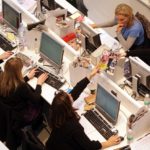By JOSH BOAK
AP Economics Writer
WASHINGTON (AP) _ U.S. productivity fell in the first quarter while labor costs rose, reflecting the economic slowdown caused at the start of the year by harsh winter weather.
The Labor Department said Wednesday that productivity declined at an annual rate of 1.7 percent in the January-March period, after growing at a 2.3 percent rate in last year’s fourth quarter.
“Special factors, namely the weather, are to blame,” said Jennifer Lee, a senior economist at BMO Capital Markets.
The falling productivity coupled with a slight increase in hourly compensation led to labor costs rising 4.2 percent in the first quarter. Labor costs had fallen in the previous two quarters.
Economic growth stalled in the first three months of this year, increasing just 0.1 percent, according to initial estimates by the Commerce Department. Freezing temperatures and snow storms disrupted growth. Retail sales and factory output plunged in January, only to recover as the weather warmed.
The economy might even have shrunk 0.6 percent during the first quarter, the research firm Marcoeconomic Advisers said Tuesday after the release of March trade data.
Productivity measures output per hour of work. Greater productivity should raise living standards because it enables companies to pay their workers more without having to increase prices, which could boost inflation.
Despite the increase in labor costs last quarter, overall inflation remains mild.
The Federal Reserve tracks productivity and labor costs when setting interest rate policies. Fed officials have attempted to spur growth by keeping short-term interest rates at record lows, while at the same time, purchasing bonds to try to keep long-term rates down as well.
Since December, however, the Fed has reduced its monthly bond-buying to $45 billion from $85 billion.
But the Fed is committed to holding down short-term rates for an extended period, saying that it expects to maintain those rates “well past” the time that unemployment dipped below its previous threshold of 6.5 percent.
The unemployment rate fell in April to 6.3 percent from 6.7 percent, a sign that economic growth should rebound in the second quarter.









